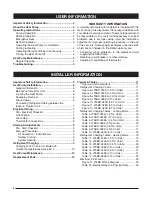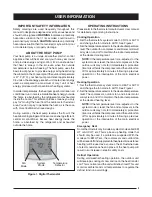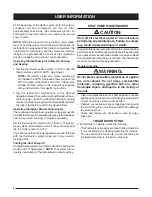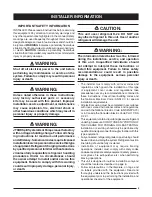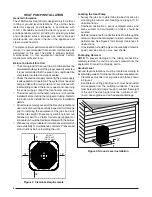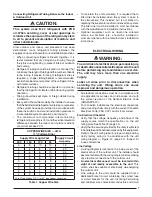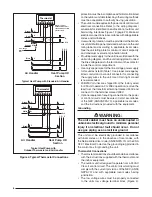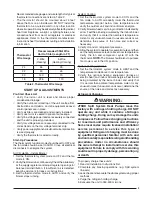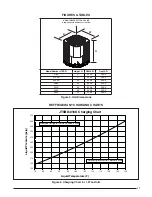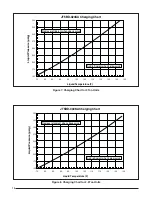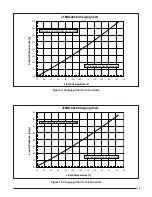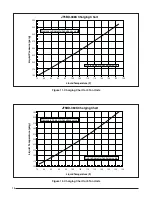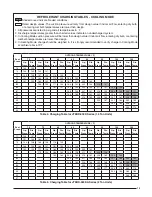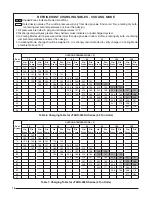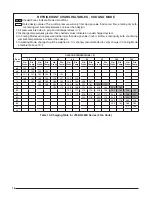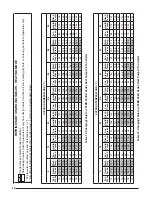
9
Table 2. Thermostat Wire Gauge
Thermostat
Wire Gauge
Recommended T-Stat Wire
Unit to T-Stat (Length in FT)
2-Wire
(Heating)
5-Wire
(Heating/Cooling)
24
55
25
22
90
45
20
140
70
18
225
110
Recommended wire gauge and wire lengths for typical
thermostat connections are listed in Table 2.
• The
thermostat should be mounted about 5 feet
above the fl oor on an inside wall. DO NOT install the
thermostat on an outside wall or any other location
where its operation may be adversely affected by radiant
heat from fi replaces, sunlight, or lighting fi xtures, and
convective heat from warm air registers or electrical
appliances. Refer to the thermostat manufacturer’s
instruction sheet for detailed mounting and installation
information.
START UP & ADJUSTMENTS
Pre-Start Check List
Verify the indoor unit is level and allows proper
condensate drainage.
Verify the outdoor coil and top of the unit are free from
obstructions and debris, and all equipment access/
control panels are in place.
Verify air fi lters are cleaned and properly installed.
Verify duct work is sealed to prevent air leakage.
Verify line voltage power leads are securely connected
and the unit is properly grounded.
Verify low voltage wires are securely connected to the
correct leads on the low voltage terminal strip.
Verify power supply branch circuit overcurrent protection
is sized properly.
Verify the thermostat is wired correctly.
Start-Up Procedures
The thermostat's function mode should be set to OFF and
the fan mode should be set to AUTO. Close all electrical
disconnects to energize the system.
Air Circulation - Indoor Blower
1. Set the thermostat system mode on OFF and the fan
mode to ON.
2. Verify the blower runs continuously. Check the air delivery
at the supply registers and adjust register openings for
balanced air distribution. If insuffi cient air is detected,
examine ductwork for leaks or obstructions.
3. Set the thermostat fan mode to AUTO and verify the
blower stops running.
System Cooling
1. Set the thermostat’s system mode to COOL and the
fan mode to AUTO. Gradually lower the thermostat
temperature setpoint below room temperature and
verify the outdoor unit and indoor blower energize.
2. Verify blower wheel is spinning in direction indicated by
arrow. Feel the air being circulated by the indoor blower
and verify that it is cooler than ambient temperature.
Listen for any unusual noises. If unusual sounds occur,
determine the source of the noise and correct as
necessary.
3. Verify HI and LO refrigerant pressures.
4. Allow the system to operate for several minutes and then
set the temperature selector above room temperature.
Verify the fan and compressor cycle off with the
thermostat.
NOTE:
The blower should also stop unless
fan mode is set to the ON position.
System Heating (optional)
1. Set the thermostat's system mode to HEAT and the
temperature mode above room temperature.
2. Verify the optional heating equipment (furnace or
electric heat) and indoor blower energize. Feel the air
being circulated by the indoor blower and verify that
it is warmer than ambient temperature. Listen for any
unusual noises. If unusual sounds occur, determine the
source of the noise and correct as necessary.
Refrigerant Charging
WARNING:
JT5BD Split System Heat Pumps leave the
factory with a nitrogen holding charge. DO NOT
operate any unit while it contains a Nitrogen
holding charge. Doing so may damage the units
compressor. Follow these charging instructions
for maximum unit performance and effi ciency.
Some local codes require licensed installation/
service personnel to service this type of
equipment. Refrigerant charging must be done
by qualifi ed personnel familiar with safe and
environmentally responsible refrigerant handling
procedures. Under no circumstances should
the owner attempt to install and/or service this
equipment. Failure to comply with this warning
could result in property damage, personal injury,
or death.
To properly charge these units:
1. Read all Installation Instructions fi rst.
2. Complete any brazing operations. (e.g. Split system
line-sets)
3. Leak check and evacuate the whole system using proper
methods.
4. Purge the nitrogen holding charge.
5. Evacuate the unit to 350-500 microns.


